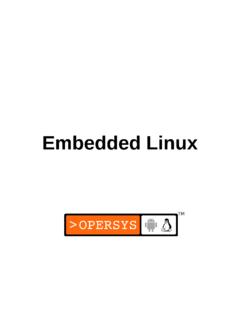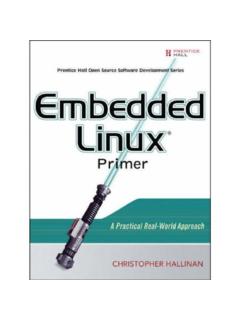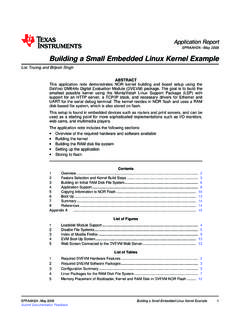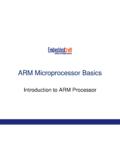Transcription of How to use the Eclipse IDE for Java Application Development
1 DIL/NetPC DNP/2486 microHOWTO S S V E M B E D D E D S Y S T E MS 2 0 0 9 , m H T 2 4 8 6 - 1 0 . d o c , R e v . 1 . 0 0 . 1 How to use the Eclipse IDE for java Application Development java Application Development is supported by many different tools. One of the most powerful and helpful tool is the free Eclipse IDE (IDE = Integrated Development Environment). To download the Eclipse IDE, go to Click on Downloads and then select the most recent stable or release version of the Eclipse SDK for your PC platform.
2 Eclipse requires java to run, so if you don t already have java installed on your machine, first install a java 6 SDK. Please note: The DIL/NetPC DNP/2486 MAX-Linux comes with a java 6 runtime environment. Your PC as a Development system needs the same java version. You can download java SDKs from Look for the java 6 J2SE SDK (Software Develop-ment Kit). 1. Step: Download the Eclipse SDK file to a temporary directory. The download file comes as a .ZIP ( ). Use your archive program to unpack Eclipse into a permanent directory ( C:\Program Files\ Eclipse ).
3 Then run the Eclipse launcher program ( C:\Program Files\ Eclipse \ ) to bring up the IDE. Eclipse comes up with a Welcome screen. This screen provides information for new users, examples and tutorials. 2. Step: Click to the Workbench icon within the Eclipse Welcome screen. After that you see the Eclipse main window, also called the workbench. Please note: The first time you start Eclipse , you will prompted for the location of your workspace. The workspace is the location where your files and settings will be stored. DIL/NetPC DNP/2486 microHOWTO S S V E M B E D D E D S Y S T E MS 2 0 0 9 , m H T 2 4 8 6 - 1 0.
4 D o c , R e v . 1 . 0 0 . 2 3. Step: Open the Eclipse File menu. Then select New to create a new java project. After that click to the item java Project within the project menu item list. This opens the New java Project dialog box. 4. Step: In the New java Project dialog box, first please enter a project name ( JavaApp1). Then select the java 6 Run Time Environment (JRE) for this project (see Use a project specific JRE). Finally press Finish. Please note: The DIL/NetPC DNP/2486 MAX-Linux comes with a java 6 runtime environment.
5 It is necessary to tell Eclipse that this new project is for java 6. DIL/NetPC DNP/2486 microHOWTO S S V E M B E D D E D S Y S T E MS 2 0 0 9 , m H T 2 4 8 6 - 1 0 . d o c , R e v . 1 . 0 0 . 3 5. Step: Please open the Eclipse File menu again. Then select Class to add a new java class. This opens the New java Class dialog box. DIL/NetPC DNP/2486 microHOWTO S S V E M B E D D E D S Y S T E MS 2 0 0 9 , m H T 2 4 8 6 - 1 0 . d o c , R e v . 1 . 0 0 . 4 6.
6 Step: In the New java Class dialog box first select the source folder for the class. Then enter the name HelloWorld for the new class. Make sure that in the Which method stubs would you like to create? area the public static void main(String[] args) check box is checked. Finally press Finish to create the new class. 7. Step: The Eclipse workbench now contains an editor window with the java source code template for the new HelloWorld class. DIL/NetPC DNP/2486 microHOWTO S S V E M B E D D E D S Y S T E MS 2 0 0 9 , m H T 2 4 8 6 - 1 0.
7 D o c , R e v . 1 . 0 0 . 5 Within the Eclipse editor window please replace the following java source code line // TODO Auto-generated method stub with ( Hello World! ); 8. Step: Please choose the Project => Properties menu item and select the compiler compliance level (this compiler level belongs to java 6) within the Properties for JavaApp1 dialog box (see JDK Compliance). DIL/NetPC DNP/2486 microHOWTO S S V E M B E D D E D S Y S T E MS 2 0 0 9 , m H T 2 4 8 6 - 1 0 . d o c , R e v.
8 1 . 0 0 . 6 9. Step: Now choose the Run => Run menu item. This starts the execution of your java Application within the Eclipse IDE. Watch the Hello World! output within the console window. Please note: The java source code of this sample is stored within the file It is not necessary to compile the source code to the class file over a menu item or a shortcut. The Eclipse IDE compiles automatically after each file save operation or before a run. The executable class file is located in the bin directory of your project (in this sample the directory.)
9 \workspace\JavaApp1\bin). Please transfer this new class file to the DNP/2486. 10. Step: Use TFTP and a Telnet session for transferring the class file. Run the class file on the DNP/2486. Use the following command sequence for this job: cd /home/user tftp DIL/NetPC DNP/2486 microHOWTO S S V E M B E D D E D S Y S T E MS 2 0 0 9 , m H T 2 4 8 6 - 1 0 . d o c , R e v . 1 . 0 0 . 7 binary get quit java HelloWorld That is all.




